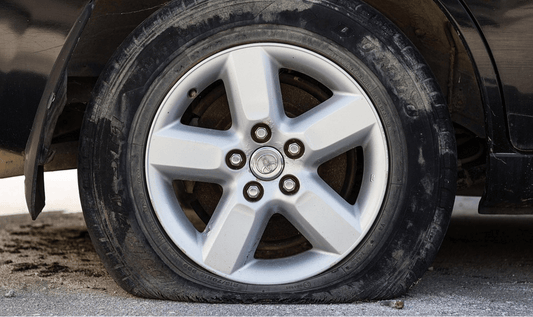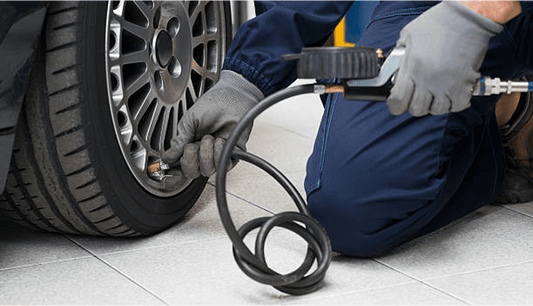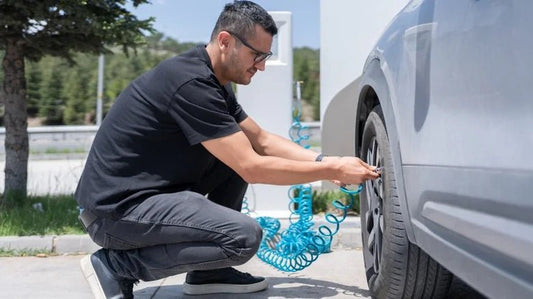Key Takeaways
- Turmeric stains on leather car seats require immediate attention, as the longer they sit, the harder they become to remove completely.
- The dish soap solution method works best for fresh turmeric stains caught within hours of the spill.
- For set-in stains, a combination of vinegar and baking soda creates a powerful cleaning agent that can lift the yellow pigment without damaging most leather surfaces.
- Always test any cleaning solution on an inconspicuous area of your leather seat first to prevent discolouration or damage.
- Ordiniq's Handheld Wired Car Vacuum Cleaner removes food particles and debris that can complicate turmeric stain removal and damage leather during cleaning.
Why Turmeric Stains Are So Stubborn on Leather Car Seats
Turmeric stains are notoriously difficult to remove, especially from porous surfaces like leather. This is because that innocent-looking yellow spice contains curcumin, a powerful pigment that's been used as a dye for thousands of years.
When this colourful culprit lands on your pristine leather car seats, it quickly penetrates beyond the surface, creating what feels like a permanent reminder of that takeout curry mishap.
The porous nature of leather makes it particularly vulnerable to turmeric's staining power, and unlike synthetic materials with protective coatings, leather absorbs the pigment deep into its fibres, where it forms a stubborn bond. This is problematic with lighter-coloured leather, where the bright yellow contrast can be especially noticeable and distressing.
Time is your greatest enemy when dealing with turmeric stains on leather because the longer the spice sits on your car seat, the deeper it penetrates and the more challenging it becomes to remove.
|
Ordiniq Handheld Car Vacuum: Drive Clean, Drive Fresh Join 10,000+ Drivers Who Keep Their Cars Spotless Why Ordiniq’s Vacuum Is Essential
What Customers Say ★★★★★"I keep this light weight vacuum cleaner in our car and handy to clean the mess created by little one. The size is small but powerful enough to clean the car seat. It also has accessories to allow to clean the small gap and corner. Definitely will buy another piece for another car. Good value too." - Connie Try It Risk-Free for 30 Days Experience spotless car interiors with zero worries. If it doesn't transform your daily commute within 30 days, we'll refund your purchase—no questions asked. FREE BONUSES: 1-Year Extended Warranty + FREE Shipping Get Ordiniq's Handheld Wired Car Vacuum Cleaner Today! *Ordiniq also offers AutoPump and a Tyre Repair Kit —great extras to keep in your boot for added peace of mind. |
Method 1: The Quick-Response Dish Soap Solution

The dish soap solution serves as your first line of defence against fresh turmeric stains, working by breaking down the oils that help the pigment adhere to leather.
When turmeric disaster strikes your leather car seat, your first line of defence should be a gentle dish soap solution.
This method works by breaking down the oils that help the turmeric pigment adhere to leather, making it easier to lift away without causing damage to your upholstery, and the beauty of this approach lies in its accessibility. You likely already have everything you need in your kitchen!
Dish soap is specifically formulated to cut through grease and lift stains, making it surprisingly effective against fresh turmeric marks when used correctly on leather surfaces.
What You'll Need
- Mild dish soap (preferably clear and unscented)
- Lukewarm water
- Clean microfibre cloths (at least 2–3)
- Small bowl for mixing solution
- Soft-bristled brush (optional for textured leather)
Step-by-Step Cleaning Process
- Begin by creating your cleaning solution by mixing one teaspoon of mild dish soap with two cups of lukewarm water. The water should be warm enough to activate the cleaning properties of the soap but not hot enough to damage the leather.
- Stir gently until the soap is fully dissolved, avoiding creating excessive bubbles that can leave residue.
- Next, dampen a clean microfibre cloth with the solution—it should be wet but not dripping. Working from the outside of the stain inward, gently blot and dab at the turmeric mark.
- Resist the urge to scrub aggressively, as this can push the stain deeper or damage the leather's finish, and for textured leather, you can use a soft-bristled brush with very light pressure to work the solution into the grain.
- After treating the area, use a fresh damp cloth with clean water to remove any soap residue, then dry the area thoroughly with another clean microfibre cloth.
- Leaving moisture on leather can lead to water stains or mildew, so ensure the surface is completely dry before finishing.
When This Method Works Best
The dish soap solution shines when dealing with fresh turmeric spills that haven't had time to set into the leather, ideally, you'll want to tackle the stain within 1–2 hours of the incident for optimal results.
Method 2: The Medium-Strength Vinegar & Baking Soda Approach

When dish soap fails, the vinegar and baking soda method provides a more powerful two-pronged attack against stubborn turmeric pigments that have had time to set.
The vinegar and baking soda approach leverages the power of acid and mild abrasion to break down stubborn turmeric pigments that have had time to set into your leather car seats.
This method works through a two-pronged attack: the acetic acid in white vinegar helps break down the turmeric's molecular structure, while baking soda provides a gentle abrasive action to lift the stain without scratching the delicate leather.
Together, they create a cleaning powerhouse that can tackle stains that have been sitting for days or even weeks.
Required Materials
For this medium-strength cleaning approach, you'll need white vinegar that serves as the acidic component that helps break down the turmeric's stubborn pigment, while baking soda provides the gentle abrasive action needed to lift the stain without damaging the leather's surface.
In addition to these two key ingredients, you'll need several microfibre cloths for application and removal, a small spray bottle for controlled application, leather conditioner to restore moisture after cleaning, a small mixing bowl for creating your paste, and a soft-bristled toothbrush for gentle application on textured leather surfaces.
Steps to Remove Set-In Turmeric Stains
- Begin by creating a vinegar solution by mixing equal parts white vinegar and water in your spray bottle. This dilution helps prevent the vinegar from being too harsh on your leather while still maintaining its stain-fighting properties.
- Lightly mist the affected area and be careful not to oversaturate the leather, which can lead to water damage or discolouration.
- After applying the vinegar solution, let it sit for approximately 5–10 minutes to begin breaking down the turmeric stain, and while you wait, prepare your baking soda paste by mixing two parts baking soda with one part water to create a thick, spreadable consistency.
- The paste should be thick enough to stay in place when applied, but not so dry that it crumbles.
- Once the vinegar solution has had time to work, gently apply your baking soda paste over the stained area using a soft cloth or toothbrush, working in small, circular motions and applying minimal pressure to avoid damaging the leather.
- Allow this paste to remain on the stain for 15–20 minutes as it draws the turmeric pigment out of the leather's pores.
- Wipe away the dried paste with a clean, slightly damp cloth, being thorough but gentle to remove all residue, then check the stain's progress and repeat the process if necessary, allowing the leather to dry completely between applications.
- Once the stain is removed, apply a small amount of leather conditioner to restore moisture and protect the cleaned area.
Safety Precautions for Different Leather Types
Before applying this method to your entire stain, it's crucial to understand that different leather types react differently to cleaning solutions.
Aniline leather, which is more porous and less protected, requires extra caution as it can easily absorb liquids and change colour, while semi-aniline and pigmented leathers typically have more protective coatings and can withstand slightly more aggressive cleaning.
Always test any cleaning solution on an inconspicuous area first, such as under a seat or in a corner, and wait 24 hours to observe any adverse reactions before proceeding with the full cleaning process.
Method 3: The Deep-Cleaning Alcohol Solution

The alcohol solution serves as your last resort before professional help, using isopropyl alcohol to dissolve deeply embedded turmeric pigments at a chemical level.
When gentler methods have failed and you're dealing with a deeply set turmeric stain that's been in your leather car seat for weeks or months, it's time to consider the heavy artillery: an alcohol solution.
This approach should be considered your last resort before seeking professional help, as alcohol can be effective but also risks damaging or drying out your leather if not used properly.
The isopropyl alcohol works by dissolving the turmeric pigment at a chemical level, which allows you to lift away stains that have become deeply embedded in the leather's structure.
Gathering Your Supplies
For this deep-cleaning method, you'll need isopropyl alcohol (70% concentration is ideal), which serves as the active stain remover due to its solvent properties.
You'll also need several clean microfibre cloths for application and removal, cotton balls or cotton swabs for precise application, and a high-quality leather conditioner to restore moisture afterward.
Application Process
Begin the deep-cleaning process by lightly dampening a cotton ball with isopropyl alcohol—it should be wet but not dripping.
Working in small, controlled areas, gently dab the stained leather, being careful not to oversaturate the surface. Then after each application, immediately blot with a clean, dry microfibre cloth to remove the dissolved turmeric pigment along with the alcohol.
Testing in an Inconspicuous Area First
Before applying an alcohol solution to a visible stain on your leather car seat, conducting a patch test is absolutely essential. Choose a hidden area of the same leather, such as underneath the seat or in a corner where the floor meets the seat, and apply a small amount of your alcohol solution using the same technique you plan to use on the stain.
Wait at least 24 hours to observe any adverse reactions like discolouration, stiffening, or texture change. This crucial testing step can save you from turning a localised turmeric stain into widespread damage across your entire car seat, especially with delicate or untreated leather types that are particularly vulnerable to harsh chemicals.
When to Stop to Prevent Leather Damage
Knowing when to stop cleaning is just as important as knowing how to clean turmeric stains from leather, so watch for warning signs that the leather is becoming compromised, such as excessive darkening beyond the stained area, a change in texture, or the leather feeling tacky to the touch.
These are all indicators that the cleaning method is too aggressive for your particular leather type. If you notice the leather starting to look dry, cracked, or discoloured in a way that differs from the stain itself, immediately stop the treatment and allow the area to dry completely.
Maintain Your Leather Car Seat with Ordiniq

At Ordiniq, our Handheld Wired Car Vacuum Cleaner helps eliminate food particles, crumbs, and accumulated dirt can create abrasive conditions that complicate stain removal.
Advanced Preparation for Emergency Cleaning
Our Handheld Wired Car Vacuum Cleaner provides essential preparation for effective turmeric stain removal by maintaining the debris-free environment that leather requires for successful cleaning.
The precision attachments work exceptionally well on leather's varied textures, removing particles from seams, perforations, and grain patterns where debris typically accumulates and can interfere with cleaning solution penetration.
Unlike battery-powered alternatives that might fail during extended cleaning sessions, our wired design ensures consistent suction throughout thorough leather preparation.
Comprehensive Stain Prevention Strategy
Our vacuum's powerful suction removes the accumulated materials that can bond with turmeric to create permanent discolouration or require aggressive cleaning that damages leather.
The multiple attachment options prove particularly valuable for leather maintenance—soft brush attachments help maintain proper grain patterns during routine cleaning, while crevice tools address the tight spaces between seat sections where spilled food typically accumulates before creating staining problems.
Enhanced Success Through Surface Management
Our integrated vehicle care system includes the AutoPump for maintaining proper tyre pressure and the Tyre Repair Kit for emergency roadside situations where clean conditions aren't available for immediate stain treatment.
Proven Performance Across the UK
More than 10,000 UK drivers have chosen our products for their reliability and versatility in real-world conditions. Our 30-day money-back guarantee means you can evaluate the Handheld Wired Car Vacuum Cleaner’s performance without any financial risk. UK customers receive additional benefits including a 1-year extended warranty and complimentary shipping at no extra cost.
| Get the Handheld Wired Car Vacuum Cleaner today! |
Frequently Asked Questions (FAQs)
Can sunlight help remove turmeric stains from leather?
Sunlight is not recommended for removing turmeric stains from leather, as while it can have a natural bleaching effect on some stains, extended exposure to direct sunlight can actually cause leather to dry out, crack, and fade.
The UV rays that might help fade the turmeric pigment will simultaneously damage the leather's structure and colour. So instead of sunlight, stick with the targeted cleaning methods outlined above that address the stain without compromising your leather's integrity.
Will leather cleaner from auto stores work on turmeric stains?
Commercial leather cleaners from auto stores can be effective on fresh turmeric stains, especially those specifically formulated for food and beverage stains. Look for pH-balanced cleaners designed for automotive leather that explicitly mention stain removal capabilities, as these products often contain gentle surfactants that can help lift the turmeric pigment without damaging the leather's finish.
However, for older, set-in stains, you may need to combine a commercial cleaner with one of the methods described above for complete removal.
How quickly should I treat a turmeric stain on leather?
Immediate action is crucial when dealing with turmeric stains on leather—ideally, you should begin the cleaning process within minutes of the spill occurring.
The longer turmeric sits on leather, the deeper the curcumin pigment penetrates into the pores and fibres, making complete removal increasingly difficult.
Can I use bleach on leather car seats to remove turmeric?
Never use chlorine bleach on leather car seats, even for stubborn turmeric stains, as bleach will irreversibly damage leather by breaking down its protein structure, causing discolouration, stiffness, and eventual cracking.
It strips the natural oils that keep leather supple and can destroy both the colour and integrity of the material. So if you've tried all the methods above without success, consult a professional leather cleaner rather than resorting to harsh chemicals like bleach.
How does regular vacuuming help with turmeric stain removal from leather?
The Ordiniq Handheld Wired Car Vacuum helps optimise turmeric stain removal by maintaining debris-free leather surfaces that allow cleaning solutions to work more effectively without interference from accumulated particles.




